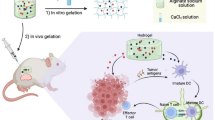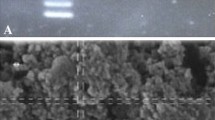Abstract
Cancer treatments consisting of a combination of chemotherapy and immunotherapy have been vigorously exploited to further improve the efficacy of cancer therapies. In this study, we utilized a chitosan hydrogel (CH) system loaded with GMCSF and a cancer drug as a chemo-immunotherapeutic agent in an effort to assess the effects on tumor growth in mice using TC-1 cervical tumor cells, which express the tumor-specific antigen, HPV-16 E7. The growth of TC-1 tumors was significantly reduced in mice treated with a CH harboring a cancer drug (doxorubicin (DOX), cisplatin (CDDP), or cyclophosphamide (CTX)) and GMCSF (CH-a cancer drug + GMCSF), as compared to other groups that were treated with CH containing only a cancer drug(CH-a cancer drug) or GMCSF(CH-GMCSF). Among the cancer drugs, CTX exerted the most potent anti-tumor effects. Interestingly, the intra-tumoral injection of CH-a cancer drug + GMCSF induced a significant E7-specific CD8+ T cell immune response as compared to CH-GMCSF or CH-a cancer drug. This enhancement of tumor antigen-specific CD8+ T cell immunity was associated principally with the anti-tumor effects induced by CH-CTX + GMCSF, as demonstrated by antibody depletion. Collectively, the aforementioned results indicate that co-treatment of tumors with a combination of GMCSF and a cancer drug incorporated into a CH system results in synergistic anti-tumor effects, which occur via the induction of a tumor antigen-specific CD8+ T cell-mediated anti-tumor immunity. This study demonstrates the use of a biodegradable hydrogel system for the co-delivery of an immunoadjuvant and an anti-cancer drug for successful chemo-immunotherapy.




Similar content being viewed by others
Abbreviations
- APC:
-
Antigen presenting cell
- CDDP:
-
Cisplatin
- CH:
-
Chitosan hydrogel
- CTL:
-
Cytotoxic T lymphocyte
- CTX:
-
Cyclophosphamide
- DCs:
-
Dendritic cells
- DOX:
-
Doxorubicin
- EGCG:
-
Epigallocatechin-3-gallate
- HPV 16:
-
Human papilloma virus 16
- IFN-γ:
-
Interferon-γ
- IL:
-
Interleukin
- MHC:
-
Major histocompatibility complex
References
Walter KA, Tamargo RJ, Olivi A et al (1995) Intratumoral chemotherapy. Neurosurgery 37:1128–1145. doi:10.1097/00006123-199512000-00013
Ning S, Yu N, Brown DM et al (1999) Radiosensitization by intratumoral administration of cisplatin in a sustained-release drug delivery system. Radiother Oncol 50:215–223. doi:10.1016/S0167-8140(98)00134-0
Bouhadir KH, Alsberg E, Mooney DJ (2001) Hydrogels for combination delivery of antineoplastic agents. Biomaterials 22:2625–2633. doi:10.1016/S0142-9612(01)00003-5
Konishi M, Tabata Y, Kariya M et al (2003) In vivo anti-tumor effect through the controlled release of cisplatin from biodegradable gelatin hydrogel. J Control Release 92:301–313. doi:10.1016/S0168-3659(03)00364-X
Han HD, Shin DC, Choi HS (2006) Doxorubicin-encapsulated thermosensitive liposomes modified with poly(N-isopropylacrylamide-co-acrylamide); Drug release behavior and stability in the presence of serum. Eur J Pharm Biopharm 62:110–116. doi:10.1016/j.ejpb.2005.07.006
Berger J, Reist M, Mayer JM et al (2004) Structure and interactions in covalently and ionically crosslinked chitosan hydrogels for biomedical applications. Eur J Pharm Biopharm 57:19–34. doi:10.1016/S0939-6411(03)00161-9
Berger J, Reist M, Mayer JM et al (2004) Structure and interactions in chitosan hydrogels formed by complexation or aggregation for biomedical applications. Eur J Pharm Biopharm 57:35–52. doi:10.1016/S0939-6411(03)00160-7
Han HD, Nam DE, Seo DH et al (2004) Preparation and biodegradation of thermosensitive chitosan hydrogel as a function of pH and temperature. Macromol Res 12:507–511
Ruel-Gariépy E, Shive M, Bichara A et al (2004) A thermosensitive chitosan-based hydrogel for the local delivery of paclitaxel. Eur J Pharm Biopharm 57:53–63. doi:10.1016/S0939-6411(03)00095-X
Zhao HR, Wang K, Zhao Y et al (2002) Novel sustained-release implant of herb extract using chitosan. Biomaterials 23:4459–4462. doi:10.1016/S0142-9612(02)00162-X
Tomihata K, Ikada Y (1997) In vitro and in vivo degradation of films of chitin and its deacetylated derivatives. Biomaterials 18:567–575. doi:10.1016/S0142-9612(96)00167-6
Han HD, Song CK, Park YS et al (2008) A chitosan hydrogel-based cancer drug delivery system exhibits synergistic antitumor effects by combining with a vaccinia viral vaccine. Int J Pharm 350:27–34. doi:10.1016/j.ijpharm.2007.08.014
Chang DZ, Lomazow W, Joy C et al (2004) Granulocyte-macrophage colony stimulating factor: an adjuvant for cancer vaccines. Hematology 9:207–215. doi:10.1080/10245330410001701549
Fleetwood AJ, Cook AD, Hamilton JA (2005) Functions of granulocyte-macrophage colony-stimulating factor. Crit Rev Immunol 25:405–428. doi:10.1615/CritRevImmunol.v25.i5.50
Simmons AD, Li B, Gonzalez-Edick M et al (2007) GM-CSF-secreting cancer immunotherapies: preclinical analysis of the mechanism of action. Cancer Immunol Immunother 56:1653–1665. doi:10.1007/s00262-007-0315-2
Dranoff G, Jaffee E, Lazenby A et al (1993) Vaccination with irradiated tumor cells engineered to secrete murine granulocyte-macrophage colony-stimulating factor stimulates potent, specific, and long-lasting anti-tumor immunity. Proc Nat Acad Sci USA 90:3539–3543. doi:10.1073/pnas.90.8.3539
Nguyen CL, Bui JT, Demcheva M et al (2001) Sustained release of granulocyte-macrophage colony-stimulating factor from a modular peptide-based cancer vaccine alters vaccine microenvironment and enhances the antigen-specific T-cell response. J Immunother 24:420–429. doi:10.1097/00002371-200109000-00004
Cole DJ, Gattoni-Celli S, McClay EF et al (1997) Characterization of a sustained-release delivery system for combined cytokine/peptide vaccination using a poly-N-acetyl glucosamine-based polymer matrix. Clin Cancer Res 3:867–873
Kim TW, Hung CF, Boyd D et al (2003) Enhancing DNA vaccine potency by combining a strategy to prolong dendritic cell life with intracellular targeting strategies. J Immunol (Baltimore, MD, 1950) 171:2970–2976
Kim TW, Hung CF, Boyd DA et al (2004) Enhancement of DNA vaccine potency by coadministration of a tumor antigen gene and DNA encoding serine protease inhibitor-6. Cancer Res 64:400–405. doi:10.1158/0008-5472.CAN-03-1475
Hsieh CJ, Kim TW, Hung CF et al (2004) Enhancement of vaccinia vaccine potency by linkage of tumor antigen gene to gene encoding calreticulin. Vaccine 22:3993–4001. doi:10.1016/j.vaccine.2004.03.057
Lake RA, Robinson BW (2005) Immunotherapy and chemotherapy—a practical partnership. Nat Rev Cancer 5:397–405. doi:10.1038/nrc1613
Nowak AK, Robinson BW, Lake RA (2003) Synergy between chemotherapy and immunotherapy in the treatment of established murine solid tumors. Cancer Res 63:4490–4496
Lake RA, van der Most RG (2006) A better way for a cancer cell to die. N Engl J Med 354:2503–2504. doi:10.1056/NEJMcibr061443
Nowak AK, Lake RA, Robinson BW (2006) Combined chemoimmunotherapy of solid tumours: improving vaccines? Adv Drug Deliv Rev 58:975–990. doi:10.1016/j.addr.2006.04.002
Jeong B, Bae YH, Lee DS et al (1997) Biodegradable block copolymers as injectable drug-delivery systems. Nature 388:860–862. doi:10.1038/42218
Molinaro G, Leroux JC, Damas J et al (2002) Biocompatibility of thermosensitive chitosan-based hydrogels: an in vivo experimental approach to injectable biomaterials. Biomaterials 23:2717–2722. doi:10.1016/S0142-9612(02)00004-2
Olson LE, Bedja D, Alvey SJ et al (2003) Protection from doxorubicin-induced cardiac toxicity in mice with a null allele of carbonyl reductase 1. Cancer Res 63:6602–6606
Chenite A, Chaput C, Wang D et al (2000) Novel injectable neutral solutions of chitosan form biodegradable gels in situ. Biomaterials 21:2155–2161. doi:10.1016/S0142-9612(00)00116-2
Song CK, Han HD, Noh KH et al (2007) Anti-cancer drugs enhance CD8+ T cell-mediated antitumor immunity induced by vaccinia virus vaccination. Mol Ther 15:1558–1563. doi:10.1038/sj.mt.6300221
Kang TH, Lee JH, Song CK et al (2007) Epigallocatechin-3-gallate enhances CD8+ T cell-mediated antitumor immunity induced by DNA vaccination. Cancer Res 67:802–811. doi:10.1158/0008-5472.CAN-06-2638
Mach N, Gillessen S, Wilson SB et al (2000) Differences in dendritic cells stimulated in vivo by tumors engineered to secrete granulocyte-macrophage colony-stimulating factor or Flt3-ligand. Cancer Res 60:3239–3246
Huang AY, Golumbek P, Ahmadzadeh M et al (1994) Role of bone marrow-derived cells in presenting MHC class I-restricted tumor antigens. Science 264:961–965. doi:10.1126/science.7513904
Daro E, Pulendran B, Brasel K et al. (2000) Polyethylene glycol-modified GM-CSF expands CD11b(high)CD11c(high) but notCD11b(low)CD11c(high) murine dendritic cells in vivo: a comparative analysis with Flt3 ligand J of Immunol (Baltimore, MD: 1950) 165: 49–58
Hung K, Hayashi R, Lafond-Walker A et al (1998) The central role of CD4(+) T cells in the antitumor immune response. J Exp Med 188:2357–2368. doi:10.1084/jem.188.12.2357
Shi FS, Weber S, Gan J et al (1999) Granulocyte-macrophage colony-stimulating factor (GM-CSF) secreted by cDNA-transfected tumor cells induces a more potent antitumor response than exogenous GM-CSF. Cancer Gene Ther 6:81–88. doi:10.1038/sj.cgt.7700012
Golumbek PT, Azhari R, Jaffee EM et al (1993) Controlled release, biodegradable cytokine depots: a new approach in cancer vaccine design. Cancer Res 53:5841–5844
Luykx-de Bakker SA, de Gruijl TD, Scheper RJ et al (1999) Dendritic cells: a novel therapeutic modality. Ann Oncol 10:21–27. doi:10.1023/A:1008349920664
Albert ML, Sauter B, Bhardwaj N (1998) Dendritic cells acquire antigen from apoptotic cells and induce class I-restricted CTLs. Nature 392:86–89. doi:10.1038/32183
Lu L, Qian S, Hershberger PA et al (1997) Fas ligand (CD95L) and B7 expression on dendritic cells provide counter-regulatory signals for T cell survival and proliferation. J Immunol (Baltimore, MD, 1950) 158:5676–5684
Honkoop AH, Pinedo HM, De Jong JS et al (1997) Effects of chemotherapy on pathologic and biologic characteristics of locally advanced breast cancer. Am J Clin Pathol 107:211–218
Dong Z, Yoneda J, Kumar R et al (1998) Angiostatin-mediated suppression of cancer metastases by primary neoplasms engineered to produce granulocyte/macrophage colony-stimulating factor. J Exp Med 188:755–763. doi:10.1084/jem.188.4.755
Pinedo HM, de Gruijl TD, van Der Wall E et al (2000) Biological concepts of prolonged neoadjuvant treatment plus GM-CSF in locally advanced tumors. Oncologist 5:497–500. doi:10.1634/theoncologist.5-6-497
Yewdell JW, Norbury CC, Bennink JR (1999) Mechanisms of exogenous antigen presentation by MHC class I molecules in vitro and in vivo: implications for generating CD8+ T cell responses to infectious agents, tumors, transplants, and vaccines. Adv Immunol 73:1–77. doi:10.1016/S0065-2776(08)60785-3
Guermonprez P, Valladeau J, Zitvogel L et al (2002) Antigen presentation and T cell stimulation by dendritic cells. Annu Rev Immunol 20:621–667. doi:10.1146/annurev.immunol.20.100301.064828
Bae SH, Park YJ, Park JB et al (2007) Therapeutic synergy of human papillomavirus E7 subunit vaccines plus cisplatin in an animal tumor model: causal involvement of increased sensitivity of cisplatin-treated tumors to CTL-mediated killing in therapeutic synergy. Clin Cancer Res 13:341–349. doi:10.1158/1078-0432.CCR-06-1838
Casares N, Pequignot MO, Tesniere A et al (2005) Caspase-dependent immunogenicity of doxorubicin-induced tumor cell death. J Exp Med 202:1691–1701. doi:10.1084/jem.20050915
Park SD, Kim CH, Kim CK et al (2007) Cross-priming by temozolomide enhances antitumor immunity of dendritic cell vaccination in murine brain tumor model. Vaccine 25:3485–3491. doi:10.1016/j.vaccine.2006.12.060
Correale P, Cusi MG, Del Vecchio MT et al (2005) Dendritic cell-mediated cross-presentation of antigens derived from colon carcinoma cells exposed to a highly cytotoxic multidrug regimen with gemcitabine, oxaliplatin, 5-fluorouracil, and leucovorin, elicits a powerful human antigen-specific CTL response with antitumor activity in vitro. J Immunol (Baltimore, MD, 1950) 175:820–828
Nowak AK, Lake RA, Marzo AL et al (2003) Induction of tumor cell apoptosis in vivo increases tumor antigen cross-presentation, cross-priming rather than cross-tolerizing host tumor-specific CD8 T cells. J Immunol (Baltimore, MD, 1950) 170:4905–4913
Mestas J, Hughes CC (2004) Of mice and not men: differences between mouse and human immunology. J Immunol (Baltimore, MD, 1950) 172:2731–2738
Acknowledgments
This study was supported by a grant from the SRC/ERC program of the KOSEF/MOST (R11-2005-017-03003-0) and a grant from the National R&D Program for Cancer Control, Ministry of Health & Welfare, Republic of Korea (070355).
Author information
Authors and Affiliations
Corresponding authors
Additional information
Soo Hong Seo and Hee Dong Han contributed equally to this paper.
Rights and permissions
About this article
Cite this article
Seo, S.H., Han, H.D., Noh, K.H. et al. Chitosan hydrogel containing GMCSF and a cancer drug exerts synergistic anti-tumor effects via the induction of CD8+ T cell-mediated anti-tumor immunity. Clin Exp Metastasis 26, 179–187 (2009). https://doi.org/10.1007/s10585-008-9228-5
Received:
Accepted:
Published:
Issue Date:
DOI: https://doi.org/10.1007/s10585-008-9228-5




